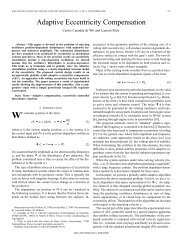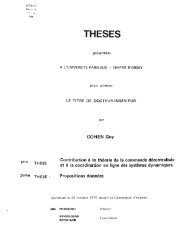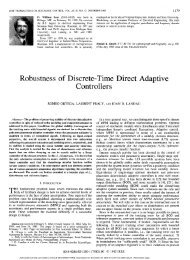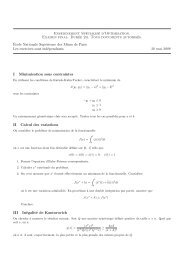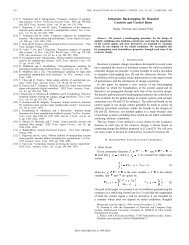Copyright © by SIAM. Unauthorized reproduction of this article is ...
Copyright © by SIAM. Unauthorized reproduction of this article is ...
Copyright © by SIAM. Unauthorized reproduction of this article is ...
You also want an ePaper? Increase the reach of your titles
YUMPU automatically turns print PDFs into web optimized ePapers that Google loves.
1844 V. ANDRIEU, L. PRALY, AND A. ASTOLFILetV (x) = ω ∞ ϕ ∞ (V m (x))V ∞ (x)+ [1 − ϕ ∞ (V m (x))] ϕ 0 (V m (x)) V m (x)+ω 0 [1 − ϕ 0 (V m (x))] V 0 (x) ,where ϕ 0 and ϕ ∞ are C 1 nondecreasing functions sat<strong>is</strong>fying(E.3)(E.4)ϕ 0 (s) = 0 ∀ s ≤ 1 2 v 0, ϕ 0 (s) = 1 ∀ s ≥ v 0 ,ϕ ∞ (s) = 0 ∀ s ≤ v ∞ , ϕ ∞ (s) = 1 ∀ s ≥ 2v ∞ .Then V <strong>is</strong> C 1 , positive definite, and proper. Moreover, <strong>by</strong> construction,⎧ω 0 V 0 (x) ∀ x : V m (x) ≤ 1 2 v 0 ,⎪⎨V (x) =⎪⎩ϕ 0 (V m (x)) V m (x)+ω 0 [1 − ϕ 0 (V m (x))] V 0 (x)∀ x :12 v 0 ≤ V m (x) ≤ v 0 ,V m (x) ∀ x : v 0 ≤ V m (x) ≤ v ∞ ,ω ∞ ϕ ∞ (V m (x))V ∞ (x) + [1 − ϕ ∞ (V m (x))] V m (x)∀ x : v ∞ ≤ V m (x) ≤ 2 v ∞ ,ω ∞ V ∞ (x) ∀ x : V m (x) ≥ 2 v ∞ .Thus for each i in {1,...,n},(E.5)and(E.6)∂V∂x i(x) = ω ∞∂V ∞∂x i(x)∀ x : V m (x) > 2 v ∞∂V∂x i(x) = ω 0∂V 0∂x i(x) ∀ x : V m (x) < 1 2 v 0 .Since ∂V∞∂x iand ∂V0∂x iare homogeneous in the standard sense, <strong>th<strong>is</strong></strong> proves that∂Vfor each i in {1,...,n},∂x i<strong>is</strong> homogeneous in the bi-limit, with weights r 0and r ∞ and degrees d V0 − r 0,i and d V∞ − r ∞,i .3. It remains to show that the Lie derivative <strong>of</strong> V along f <strong>is</strong> negative definite.To <strong>th<strong>is</strong></strong> end note that, for all x such that 1 2 v 0 ≤ V m (x) ≤ v 0 ,∂V∂x (x)f(x) = ϕ′ 0(V m (x)) [V m (x) − ω 0 V 0 (x)] ∂V m∂x (x)f(x)+ ω 0 [1 − ϕ 0 (V m (x))] ∂V 0∂x (x)f(x)+ϕ 0(V m (x)) ∂V m∂x (x)f(x)and, for all x such that v ∞ ≤ V m (x) ≤ 2 v ∞ ,∂V∂x (x)f(x) = ϕ′ ∞(V m (x)) [ω ∞ V ∞ (x) − V m (x)] ∂V m∂x (x)f(x)+ ω ∞ ϕ ∞ (V m (x)) ∂V ∞∂x (x)f(x) + [1 − ϕ ∞(V m (x))] ∂V m∂x (x)f(x) .By (D.2), (E.1), (E.2), (E.3), and (E.4), these inequalities imply∂V(x) f(x) < 0 ∀ x ≠ 0 ,∂xwhich proves the claim.<strong>Copyright</strong> © <strong>by</strong> <strong>SIAM</strong>. <strong>Unauthorized</strong> <strong>reproduction</strong> <strong>of</strong> <strong>th<strong>is</strong></strong> <strong>article</strong> <strong>is</strong> prohibited.




